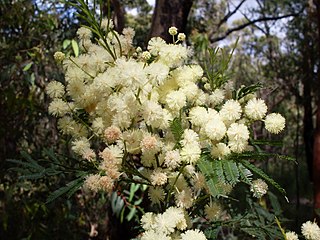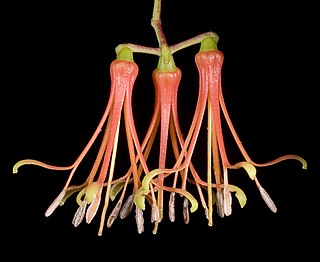
Acacia parramattensis, commonly known as Parramatta wattle, is a tree of the family Fabaceae native to the Blue Mountains and surrounding regions of New South Wales. It is a tall shrub or tree to about 15 m (49 ft) in height with phyllodes instead of true leaves. These are finely divided bipinnate. The yellow flowers appear over summer. It generally grows in woodland or dry sclerophyll forest on alluvial or shale-based soils, generally with some clay content.

Amyema is a genus of semi-parasitic shrubs (mistletoes) which occur in Malesia and Australia.

Angophora floribunda, commonly known as the rough-barked apple, is a common woodland and forest tree of the family Myrtaceae native to Eastern Australia. Reaching 30 m (100 ft) high, it is a large tree with fibrous bark and cream-white flowers that appear over the Austral summer. It grows on alluvial soils on floodplains and along watercourses. Much of the land it grew on has been cleared for agriculture.

Amyema quandang is a species of hemi-parasitic shrub which is widespread throughout the mainland of Australia, especially arid inland regions, sometimes referred to as the grey mistletoe.

Amyema preissii, commonly known as wireleaf mistletoe, is a species of mistletoe, an epiphytic, hemiparasitic plant of the family Loranthaceae. It is native to Australia where it has been recorded from all mainland states. The flowers are red and up to 26 mm long. The fruits are white or pink, globose and 8–10 mm in diameter. Its habitat is sclerophyll forest and woodland where it is often found on wattles. On Victoria's Bellarine Peninsula its hosts include coast wirilda, golden wattle and drooping sheoak. Its sticky seeds are eaten and dispersed by mistletoebirds.

Amyema pendula, also known as drooping mistletoe or furry drooping mistletoe, is a species of flowering plant, an epiphytic hemiparasitic plant of the family Loranthaceae, found attached to several species of Australian eucalypt and occasionally on some species of Acacia. It is endemic to south-eastern Australia. It is the most common mistletoe in Victoria, especially on the coastal side of the Great Dividing Range. It has shiny leaves and red flowers arranged in groups of 3 or 4. It is distinguished from the similar Amyema miquelii through the lack of individual stalks on the flowers.

Amyema benthamii, commonly known as the twin-leaved mistletoe or Bentham's mistletoe, is a species of flowering plant, an epiphytic hemiparasitic plant of the family Loranthaceae native to Western Australia and the Northern Territory of Australia in semi-arid woodland. This species is named in honour of the English botanist George Bentham who between 1863 and 1878 published Flora Australiensis, the first flora of Australia.

Lysiana exocarpi, commonly known as harlequin mistletoe, is a species of hemiparasitic shrub, endemic to Australia. It is in the Gondwanan family Loranthaceae and is probably the most derived genus of that family with 12 pairs of chromosomes. The Loranthaceae is the most diverse family in the mistletoe group with over 900 species worldwide and including the best known species in Australia. Mistletoes are notable for their relationships with other species. In an early reference to the group in Australia Allan Cunningham explorer and first Director of the Royal Botanic Gardens, Sydney, wrote in 1817: "The Bastard Box is frequently much encumbered with the twining adhering Loranthus aurantiacus which 'Scorning the soil, aloft she springs, Shakes her red plumes and claps her golden wings'."

Atkinsonia is a hemi-parasitic shrub with oppositely set, entire leaves and yellowish, later rusty-red colored flowers, that is found in Eastern Australia. It is a monotypic genus, the only species being Atkinsonia ligustrina, and is assigned to the showy mistletoe family, Loranthaceae. It is sometimes called Louisa's mistletoe.

Eucalyptus exserta, commonly known as Queensland peppermint, peppermint, bendo, yellow messmate or messmate, is a species of tree or a mallee and is endemic to eastern Australia. It has hard, fibrous bark, lance-shaped adult leaves, flower buds in groups of seven, white flowers and hemispherical or cup-shaped fruit.

Amyema gaudichaudii, commonly known as melaleuca mistletoe, is a plant in the family Loranthaceae endemic to eastern Australia. Like other mistletoes, it is a shrubby, woody, aerial hemiparasite plant. It has relatively small, wedge-shaped leaves and small, dark red flowers arranged in groups of three. It only grows on a few species of Melaleuca.

Amyema maidenii is a species of flowering plant within the genus Amyema, an epiphytic hemiparasitic plant of the family Loranthaceae native to Australia and found Australia-wide in the inland.

Amyema mackayensis, the mangrove mistletoe, is a species of flowering plant within the genus Amyema, an epiphytic hemiparasitic plant of the family Loranthaceae native to Australia, and found along its northern and eastern coasts in New South Wales, Queensland, the Northern Territory and Western Australia, and also in New Guinea.

Amyema fitzgeraldii, the pincushion mistletoe, is a species of flowering plant within the genus Amyema, an epiphytic hemiparasitic plant of the family Loranthaceae endemic to Australia, and found in the Northern Territory, South Australia and Western Australia.

Amyema biniflora, the twin-flower mistletoe, is a species of flowering plant within the genus Amyema, an epiphytic hemiparasitic plant of the family Loranthaceae endemic to Queensland, Australia.

Amyema sanguinea is an aerial hemiparasitic shrub within the genus Amyema, in the family Loranthaceae and native to Australia, where it is found in New South Wales, Queensland, the Northern Territory, South Australia and Western Australia.

Amyema gibberula is an aerial hemiparasitic plant of the family Loranthaceae native to Australia and found in Western Australia, the Northern Territory, and South Australia.

Amyema melaleucae, also known as the tea-tree mistletoe, is a species of flowering plant within the genus Amyema, an epiphytic hemiparasitic plant of the family Loranthaceae native to Australia and found in Western Australia and South Australia on the coast, from north of Perth almost to the Victorian border.

Muellerina bidwillii, common name Cypress-pine mistletoe, is a hemiparasitic aerial shrub in the family Loranthaceae. The species is endemic to New South Wales and Queensland.
Amyema plicatula is a species of hemi-parasitic shrub found in the Bismarck Archipelago, New Guinea, New South Wales and Queensland.



















